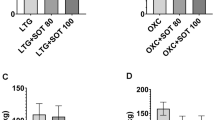Summary
Male mice were administered electric convulsive shocks (ECS) once daily for one (ECS×I), three (ECS×III) or seven days (ECS×VII). One (day 1), three (day 3) or six days (day 6) later they received reserpine 10 mg/ kg, followed 2 hours later by clonidine, 1.5 mg/kg, and/or apomorphine, 1.5 mg/kg. Control animals received the same drug treatments but no ECS. The motor activity was recorded for 1 hour, starting immediately after the last drug injection. The behavioural depression induced by reserpine was equally pronounced in ECS-pretreated animals as in the control animals. The psychomotor stimulant effects of clonidine and/or apomorphine, given after reserpine was, however, enhanced by pretreatment with ECS×VII, day 1. Pretreatment with ECS×VII increased the motor activity also in animals given reserpine, apomorphine and clonidine at day 3 or day 6. ECS×III was also effective in this respect at day 1, whereas ECS×I, day 1, was ineffective. Mice given ECS×VII but no drug treatment showed at day 1 an increased motor activity during the initial 10 min and a decreased activity during the last 10 min of the 1 hour recording period. At day 3 and day 6 after ECS×VII the motor activity was increased in comparison to that in untreated control animals during the whole 1 hour period. Animals given repeated ECS furthermore showed increased irritability and reduced body weight.
The results indicate that repeated ECS increase the sensitivity of post-synaptic catecholamine receptors in the brain or alter neuronal structures which are connected to these receptors.
Similar content being viewed by others
References
Aird, R. B.: Clinical correlates of electroshock therapy. Arch. Neurol. Psychiat.79, 633–639 (1958).
Andén, N.-E., A. Carlsson, andJ. Häggendal: Adrenergic mechanisms. Ann. Rev. Pharmacol.9, 119–133 (1969).
Andén, N.-E., H. Corrodi, K. Fuxe, B. Hökfelt, T. Hökfelt, C. Rydin, andT. Svensson: Evidence for a central noradrenaline receptor stimulation by clonidine. Life Sci.9, 513–523 (1970).
Andén, N.-E., A. Rubenson, K. Fuxe, andT. Hökfelt: Evidence for dopamine receptor stimulation by apomorphine. J. Pharm. Pharmacol.19, 627–629 (1967).
Andén, N.-E., andU. Strömbom: Adrenergic receptor blocking agents: Effects on central noradrenaline and dopamine receptors and on motor activity. Psychopharmacologia (Berl.)38, 91–103 (1974).
Andén, N.-E., U. Strömbom, andT. H. Svensson: Dopamine and noradrenaline receptor stimulation: reversal of reserpine-induced suppression of motor activity. Psychopharmacologia (Berl.)29, 289–298 (1973).
Bjerner, B., T. Broman, andÅ. Swensson: Tierexperimentelle Untersuchungen über Schädigungen der Gefäße mit Permeabilitätsstörungen und Blutungen im Gehirn bei Insulin-, Cardiazolund Elektroschockbehandlung. Acta psychiat. neurol. scand.19, 431–452 (1944).
Coppen, A.: The biochemistry of affective disorders. Brit. J. Psychiat.113, 1237–1264 (1967).
Engström, G., T. H. Svensson, andB. Waldeck: Thyroxine and brain catecholamines: increased transmitter synthesis and increased receptor sensitivity. Brain Research77, 471–483 (1974).
Ernst, A. M.: Mode of action of apomorphine and dexamphetamine on gnawing compulsions in rats. Psychopharmacologia (Berl.)10, 316–323 (1967).
Kety, S. S.: Biochemical and neurochemical effects of electroconvulsive shock. In: Psychobiology of Convulsive Therapy (Fink, M., S. Kety, J. McGaugh, andT. A. Williams, eds.). Washington, D.C.: V. H. Winston & Sons. 1974.
Matussek, N., andW. Ladisich: Chronic administration of electroconvulsive shock and norepinephrine metabolism in the rat brain. III. Influence of acute and chronic electroshock upon drug-induced behaviour. Psychopharmacologia (Berl.)15, 305–309 (1969).
Papeschi, R., A. Randrup, andS. Lal: Effect of ECT on dopaminergic and noradrenergic mechanisms. Psychopharmacologia (Berl.)35, 149–158 (1974).
Pryor, G. T.: Effect of repeated ECS on brain weight and brain enzymes. In: Psychobiology of Convulsive Therapy (Fink, M., S. Kety, J. McGaugh, andT. A. Williams, eds.). Washington, D.C.: V. H. Winston & Sons. 1974.
Pryor, G. T., andL. S. Otis: Persisting effects of chronic electroshock seizures on brain and behaviour in two strains of rats. Physiol. Behav.5, 1053 to 1055 (1970).
Pryor, G. T., S. Peache, andM. K. Scott: The effect of repeated electroconvulsive shock on avoidance conditioning and brain monoamine oxidase activity. Physiol. Behav.9, 623–628 (1972).
Rosenblatt, S., J. D. Chanley, H. Sobotka, andM. R. Kaufman: Interrelationships between electroshock, the blood-brain barrier, and catecholamines. J. Neurochem.5, 172–176 (1960).
Rossum, J. M. van: Mode of action of psychomotor stimulant drugs. Int. Rev. Neurobiol.12, 307–383 (1970).
Schildkraut, J. J.: Neuropsychopharmacology and the Affective Disorders. Boston: Little Brown. 1970.
Waldeck, B.: Ethanol and caffeine: a complex interaction with respect to locomotor activity and central catecholamines. Psychopharmacologia (Berl.)36, 209–220 (1974).
Woodbury, L. A., andV. D. Davenport: Design and use of a new electroshock seizure apparatus and analysis of factors altering seizure threshold and pattern. Arch. int. Pharmacodyn.92, 97–107 (1952).
Author information
Authors and Affiliations
Rights and permissions
About this article
Cite this article
Modigh, K. Electroconvulsive shock and postsynaptic catecholamine effects: Increased psychomotor stimulant action of apomorphine and clonidine in reserpine pretreated mice by repeated ECS. J. Neural Transmission 36, 19–32 (1975). https://doi.org/10.1007/BF01243434
Received:
Issue Date:
DOI: https://doi.org/10.1007/BF01243434




